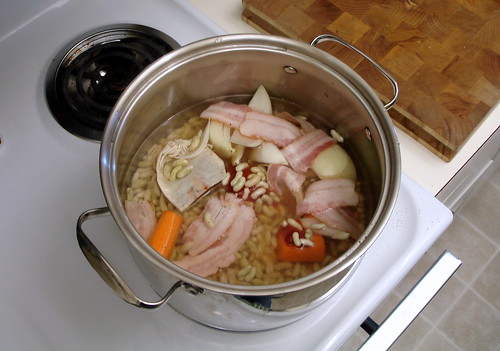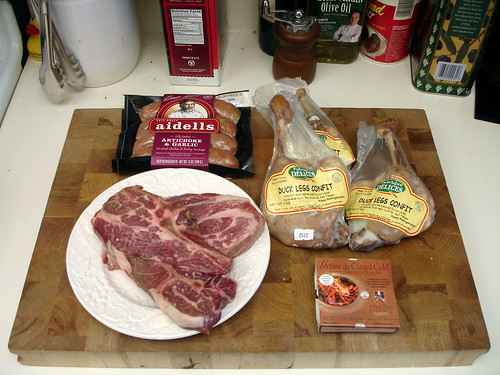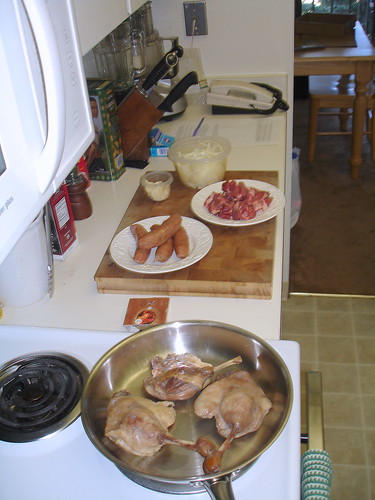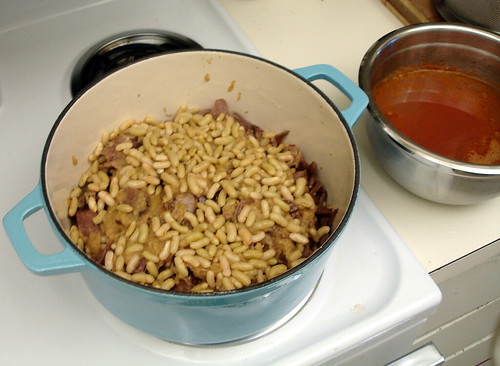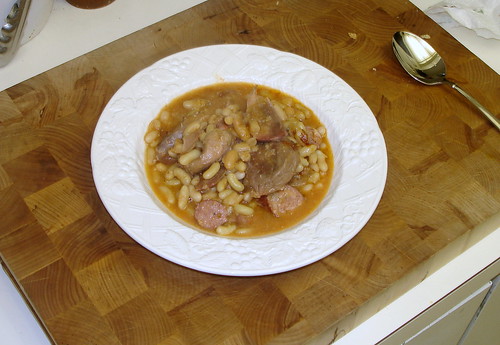(Serves six, if you’re lucky)
For the pork belly:
3 pounds raw, uncured pork belly, skin on
2 cups kecap manis*
6 tablespoons Chinese black vinegar*
3 tablespoons dark soy sauce*
3 tablespoons Thai or Vietnamese fish sauce (called nouc nam or nam pla)
1 tablespoon lime juice
1 round of jaggery (palm sugar)*+ or ¼ cup light brown sugar
1. Crosshatch pork belly, with cuts ½” apart and ¼” deep. Place pork in a bowl, and combine kecap manis, vinegar, soy, fish sauce and lime juice. Pour over the pork belly and marinate 24 to 48 hours, turning occasionally.
2. Preheat oven to 275˚. Place belly, skin up, in baking pan or oven-safe skillet with two cups of marinade and 2 cups water, covering pork half-way up (add more water if needed). Cover pan with foil (or use lid with the skillet), and bake 3-4 hours. Remove pork from the liquid and cool. Cut belly into 1-inch chunks, with the skin on.
3. In a large sauté pan over medium heat, cook palm sugar until it dissolves and turns amber, and gently toss the pork belly chunks, until coated. (Be careful not to separate the belly from the skin).
For the risotto:
4cups water, plus 4cups saké, hot
2 tablespoons olive oil
6 tablespoons unsalted butter
1 medium onion, finely diced
2 tablespoons garlic, finely diced
1 pound fresh cremini mushrooms, trimmed and thinly sliced
1 cup Arborio, Carnaroli or Vialone Nano rice (preferably, Vialone Nano)
1 cup mirin (Japanese rice vinegar)
1 teaspoon salt
½ teaspoon black pepper
1. Combine water and saké and heat. Simmer on low until ready to use.
2. Heat oil and 1 tablespoon of the butter in a large saute pan over medium-high heat until foam subsides, then sauté onion, stirring, until softened, about 5 minutes.
3. And garlic and muhrooms and sauté, stirring, until mushrooms are browned and any liquid the mushrooms have released has cooked off, about 8 minutes. Add rice and cook, stirring, for 1 minute. Add mirin and cook, stirring, until absorbed, about five minutes. (Did I mention that risotto is all about stirring? It’s all about stirring.)
4. Stir 1 cup of the simmered saké broth into the rice and stir, keeping it at a strong simmer until absorbed. Continue cooking and adding broth, about 1 cup at a time, stirring and waiting until each cupful is absorbed, until rice is creamy but al dente, 18-20 minutes. (This is what separates the Italians from the weenies. Small blisters should be developing at this point, and your palms should be red and sore from all that figure-8 pattern-stirring with the Big Italian Wooden Spoon, but there’s no whining in risotto-making. Oh, no. Suck it up and keep stirring, all’onda (wavy patterns), as the Venetians say, and NEVER turn your back on your risotto, or it’ll dry out and mound up like a plate of spackle. Trust a northern Italian on this.)
5. Remove from heat, and stir in salt, pepper and remaining butter until butter is melted. (This replaces the need for finishing the risotto with cream or cheese, which would work against the saké/mirin flavor.) Pour a glass of cold saké (really good saké is served cold), and, while congratulating yourself, honor the kitchen gods of Mario Batali, David Chang and Ming Tsai, add saké to self – and get a hold of the pork belly before people start coming by “just to pick”.
* Kecap manis (KEH-chop mah-NEES) is a thick, sweet soy sauce from Indonesia, and is available from Kalustyan’s in New York and on-line, as well as Wegman’s. Kalustyan’s also carries the black Chinese vinegar and the dark soy, which is darker and richer than what you find in the supermarket.
+ Palm sugar is available from Bangkok Market in New York and on-line, and is also at Kalustyan’s, I believe.
